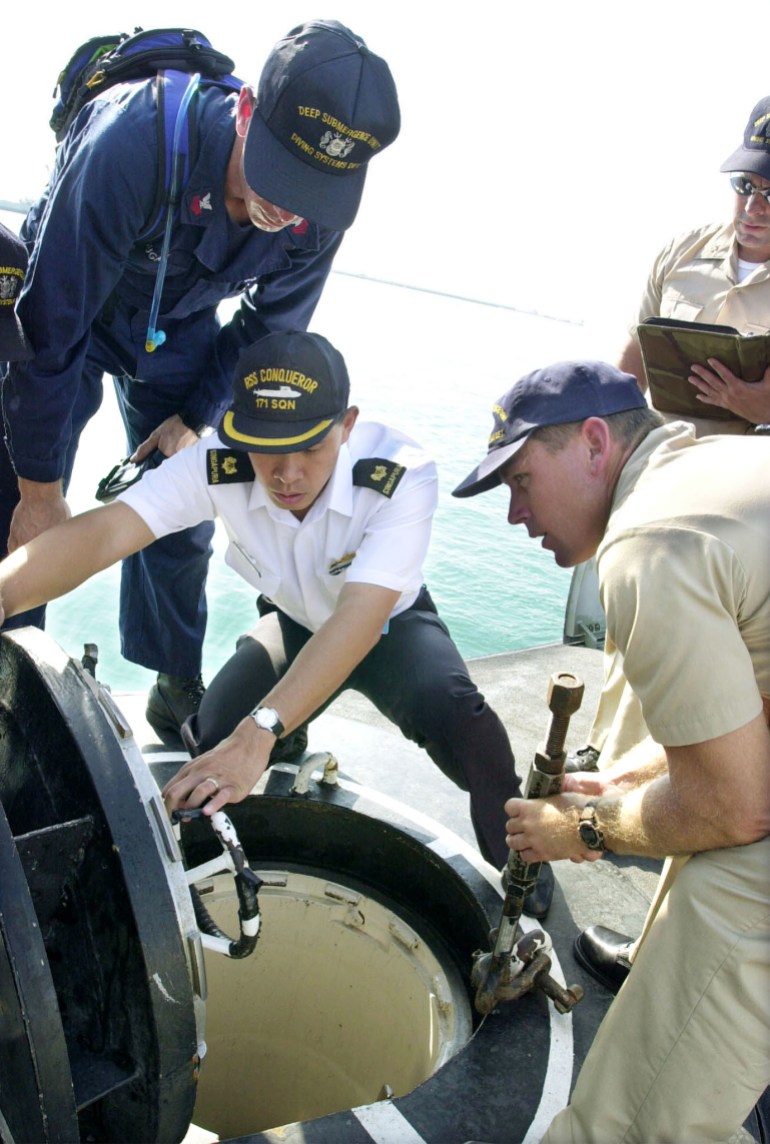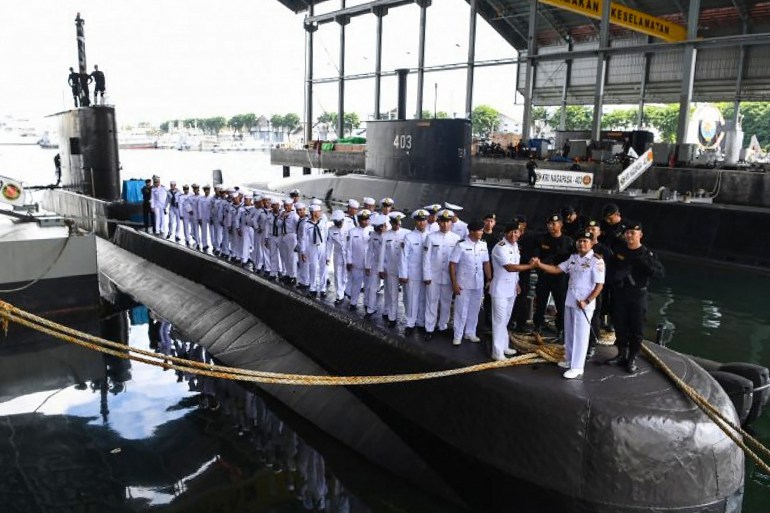Facing ‘morale blow’, Indonesia steps up search for submarine | Military News
Rescue teams in Indonesia have stepped up their search for a submarine and its 53-person crew that went missing more than 24 hours ago, as experts expressed their concern about the consequences of a possible maritime disaster on the archipelago on Thursday.
The KRI Nanggala-402 was conducting live-fire torpedo exercises north of the island of Bali when it lost contact at about 3am on Wednesday morning (20:00 GMT on Tuesday). According to an internal Indonesian Navy report, seen by Al Jazeera, a distress signal was sent by the Indonesian authorities to the International Submarine Escape and Rescue Liaison Office (ISMERLO) on Wednesday afternoon. ISMERLO coordinates international submarine search and rescue operations and the Singapore Navy and the Australian Navy responded to the distress signal, according to the report.
“Singapore has a specially built submarine rescue ship along with a Deep-Submergence Rescue Vessel (DSVR) to perform complex rescue operations. Indonesia has no such equivalent capability,” Collin Koh, a research fellow at the S Rajaratnam School of International Studies in Singapore who specialises in naval affairs and maritime security, told Al Jazeera.
The two countries signed a submarine rescue pact in 2012, and Singapore’s Defence Minister Ng Eng Hen wrote on social media on Thursday that the vessel – MV Swift Rescue – had been dispatched “as fast as she could get ready”. A medical team was also on board.
“It is only natural that we do whatever we can to assist in times like this,” he wrote on Facebook.
“The extent to which it can help will very much depend on first pinpointing the boat’s exact location, the prevailing weather conditions, the sea conditions and most importantly establishing the crew’s status,” Koh said.
“There is no political hurdle in this unlike what happened in 2000 after the Russian submarine Kursk sank and Moscow initially resisted foreign help until it was too late. So time is of the essence.”
 Deep Submergence Vessels, operated by navies from countries including Singapore and the US, are crucial to submarine rescue [File: Terry Cosgrove/US TC/JD via Reuters]
Deep Submergence Vessels, operated by navies from countries including Singapore and the US, are crucial to submarine rescue [File: Terry Cosgrove/US TC/JD via Reuters]Singapore has similar submarine rescue agreements with Australia, South Korea, Vietnam, the United States and India.
The Indonesian Navy report also said that an oil slick was discovered at approximately 7am (00:00 GMT) on Wednesday after a helicopter was sent to the last known position of the KRI Nanggala-402, although it has not been confirmed if this was related to the potentially stricken submarine.
“Marine pollution in regional waters is common, when ships discharge lubricants and other noxious substances in the waters illegally,” Koh said. “Even if we do establish the spill is from the submarine, it also depends on the extent to which the boat is damaged. This requires the specialised assets used in the rescue to locate the boat, make contact with it and perform necessary visual inspection.”
Lack of maritime defence
Natalie Sambhi, the executive director of Verve Research, a multidisciplinary research collective focusing on Southeast Asia’s militaries, told Al Jazeera that the incident showed the need for Indonesia to maintain its systems, in terms of the armed forces’ equipment and its soldiers, airmen and crew.
“Given the age of some of Indonesia’s naval platforms, this doesn’t surprise completely but it dismays,” she said. “It could be more of a morale blow at a time when Indonesia really needs to have a strong maritime defence system. China, primarily, has stepped up the scale of its incursions in Southeast Asian Exclusive Economic Zones (EEZs), against Indonesia and notably against the Philippines of late.”
Indonesia previously had a fleet of 12 submarines, although it now only operates five, two of which, including the KRI Nanggala-402, are German-built. The other three are more modern submarines from South Korea. There are also plans to buy more submarines from South Korea by 2024, although Sambhi said that these are needed urgently given Indonesia is the world’s largest archipelagic nation.
“The Navy is one pillar of maritime defence, including others such as the coastguard but five submarines for such a large archipelago is woefully insufficient,” she added.
The country is made up of more than 17,000 islands, and maritime disputes have grown in recent years, particularly with China whose fishing vessels have been found operating illegally in Indonesia’s waters.
Rescue difficult
In its “Interim Analysis” published in the internal report, the Indonesian Navy speculated that a possible blackout occurred on the KRI Nanggala-402 which made it impossible to control the vessel or invoke emergency procedures including activating an emergency button which would have allowed the submarine to resurface.
The report added that the submarine is thought to have fallen to a depth of between 600 and 700 metres (1,968 – 2,296 feet) and that the presence of an oil slick perhaps indicated fuel tank damage or cracking due to seawater pressure.
 Concern is growing for the crew of the KRI Nanggal-402 seen here at the naval base in Surabaya, Indonesia’s second biggest city [File: Indonesian military via AFP]
Concern is growing for the crew of the KRI Nanggal-402 seen here at the naval base in Surabaya, Indonesia’s second biggest city [File: Indonesian military via AFP]The KRI Nanggala-402 was carrying 53 personnel according to the Navy report, including 49 crew, one unit commander and three arsenal personnel and was headed by Marine Lt Col Heri Octavian.
A former British naval officer and maritime lawyer, speaking to Al Jazeera on condition of anonymity, said that other possible explanations for the loss of contact from the KRI Nanggala-402 included a torpedo or weapon explosion, collision with an underwater vessel or object, oxygen failure, accidental flooding or a structural failure.
“Crushing of the hull must be likely at this depth and, as oil has been seen on the surface, it could indicate a catastrophic structural failure, particularly as the vessel was old, having been built in 1977 and delivered to the Indonesian Navy in 1981.”
RSN’s MV Swift Rescue – our submarine rescue vessel – was dispatched expeditiously yesterday afternoon, as fast as she could get ready, after our Navy Chief received a request for assistance from his @_TNIAL_ counterpart. A medical team was also added… https://t.co/SD2jhjROMH pic.twitter.com/sXPSnfvDai
— Ng Eng Hen (@Ng_Eng_Hen) April 22, 2021
He also added that the depth of the submarine could make any potential rescue challenging.
“It is very difficult to effect rescue at this depth as the usual way would be with a diving bell lowered and attached to the escape hatch, which is almost certainly impossible if the submarine is indeed at a depth of 700 metres [2,296 feet],” he said.
“I am not hopeful for this crew.”
